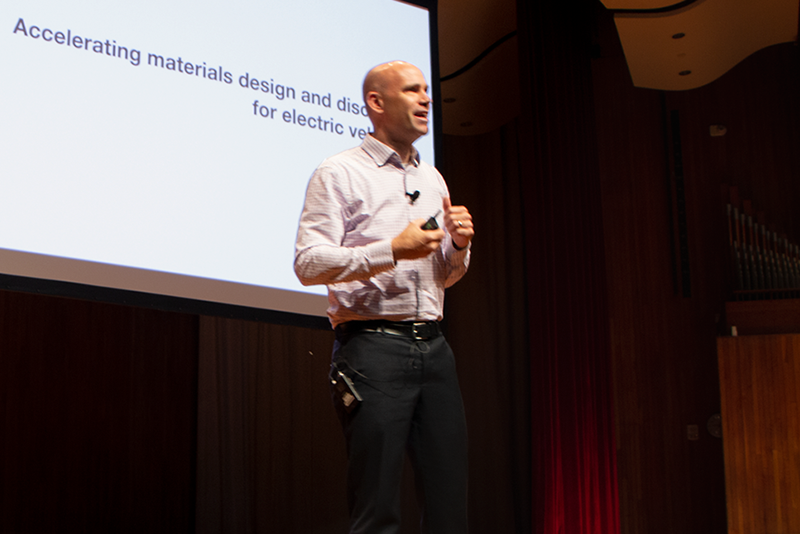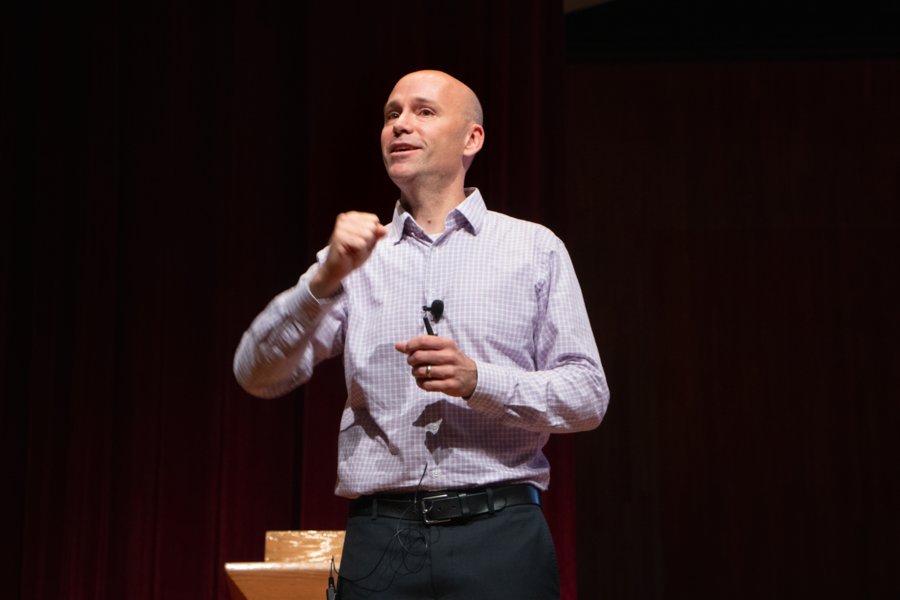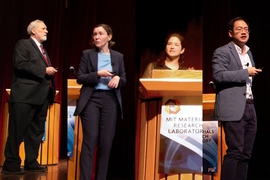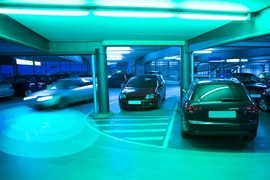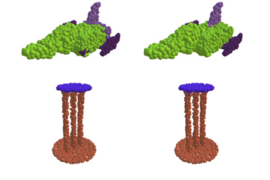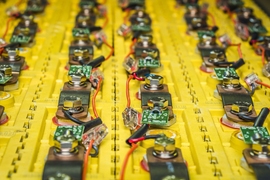With 100 million Toyota vehicles on the planet emitting greenhouse gases at a rate roughly comparable to those of France, the Toyota Motor Corporation has set a goal of reducing all tailpipe emissions by 90 percent by 2050, according to Brian Storey, who directs the Toyota Research Institute (TRI) Accelerated Materials Design and Discovery program from its Kendall Square office in Cambridge, Massachusetts. He gave the keynote address at the MIT Materials Research Laboratory's Materials Day Symposium on Oct. 9.
“A rapid shift from the traditional vehicle to electric vehicles has started,” Storey says. “And we want to enable that to happen at a faster pace.”
“Our role at TRI is to develop tools for accelerating the development of emissions-free vehicles,” Storey said. He added that machine learning is helping to speed up those innovations, but the challenges are very great, so his team has to be a little humble about what it can actually accomplish.
Electrification is just one of four “disrupters” to the automotive industry, which are often abbreviated CASE (connected, autonomous, shared, electric). “It’s a disrupter to the industry because Toyota has decades of experience of optimizing the combustion engine,” Storey said. “We know how to do it; it’s reliable; it’s affordable; it lasts forever. Really, the heart of the Toyota brand is the quality of the combustion engine and transmission.”
Storey stated that as society shifts toward electrification — battery or fuel cell vehicles — new capability, technology, and know-how is needed. Storey says “while Toyota has a lot of experience in these areas, we still need to move faster if we are going to make this kind of transition.”
To help with that acceleration, Toyota Research Institute is providing $10 million a year to support research of approximately 125 professors, postdocs, and graduate students at 10 academic institutions. About $2 million a year of that research is being done at MIT. Storey is also a professor of mechanical engineering at Olin College of Engineering.
For example, the Battery Evaluation and Early Prediction (BEEP) project, which is a TRI collaboration with MIT and Stanford University, aims to expand the value of lithium-based battery systems. In experiments, many batteries are charged and discharged at the same time. “From that data alone, the charge and discharge data, we can extract features. It’s super practical because we get the data. We extract features from the data, and we can correlate those features with lifetime,” Storey explained.
The traditional way of testing whether a battery is going to last for a thousand cycles is to cycle it for a thousand times. Storey noted that if each cycle takes one hour, one battery requires 1,000 hours of testing. “What we want to do is bring that time way back, and so our goal is to able to do it in five — to cycle five times and get a good estimate of what the battery’s lifetime would be at 1,000 cycles, doing it purely from data,” Storey said.
Published results in Nature Energy in March 2019 show just a 4.9 percent test error using data in classifying lithium-ion batteries from the first five charge/discharge cycles.
“This is a nice capability because it actually allows acceleration in testing,” Storey noted. “It’s using machine learning, but it’s really using it at the device scale, the ‘as-manufactured’ battery.”
The cloud-based battery evaluation software system allows TRI to collaborate easily with colleagues at MIT, Stanford, and Toyota’s home base in Japan, he said.
Program researchers operate it in a closed-loop, semi-autonomous way, where the computer decides and executes the next-best experiment. The system finds charging policies that are better than ones that have been published in the literature, and it finds them rapidly. “The key to this is the early prediction model, because if we want to predict the lifetime, we don’t have to do the whole test.” Storey added that the closed-loop testing “pulls the scientist up a level in terms of what questions they can ask.”
TRI would like to use this closed-loop battery evaluation system to optimize the first charge/discharge cycle a battery goes through, which is called formation cycling. “It’s like caring for the battery when it’s a baby,” Storey explained. “How you do those first cycles actually sets it up for the rest of its life. It’s a real black art, and how do you optimize this process?”
TRI’s long-term goal is to improve battery durability so that, from the consumer point of view, the battery capacity never goes down. Storey emphasized “we want the battery in the car to just last forever.”
Storey notes TRI is also conducting two other research projects, AI-Assisted Catalysis Experimentation (ACE) with CalTech to improve catalysts for fuel cell vehicles such as Toyota’s Mirai, and a materials synthesis project, mostly within TRI, to use machine learning to identify whether or not the new materials predicted on the computer are likely to be synthesizable.
For the materials synthesis project, TRI began with the phase diagrams of materials. “You build up a network of every material you’ve got in the computational database and look at features of the network. Believing that somehow those materials are connected to other materials through the relationship in this network provides a prediction of synthesizability,” Storey explained. “The way you can train the algorithm is by looking in the historical record of when certain materials were synthesized. You can virtually roll the clock back, pretending to know only what you knew in 1980, and use that to train your algorithm.” A report on the materials synthesis network was published in May in Nature Communications.
TRI is collaborating with Lawrence Berkeley National Laboratory (LBNL) and MIT Professor Martin Z. Bazant on a project that couples highly detailed mechanics of battery particles revealed through 4D scanning tunneling electron microscopy with a continuum model that captures larger-scale materials properties. “This program figures out the reaction kinetics and thermodynamics at a continuum scale, which is otherwise unknown,” Storey said.
“We’re putting our software tools online, so over the coming year many of these tools will start becoming available,” Storey explained. Hosted by LBNL, the Propnet materials database is already accessible to internal collaborators. Matscholar is accessible through GitHub. Both projects were funded by TRI.
“Our dream, which is a work in progress, is to have a system architecture that overlies all these projects and can start to tie them together,” Storey said. “We are creating a system that’s built for machine learning from the start, allows for diverse data, allows for systems and atom-scale measurements, and is capable of this idea of AI-driven feedback and autonomy. The idea is that you launch the system and it runs on its own, and everything lives in the cloud to enable collaboration.”
